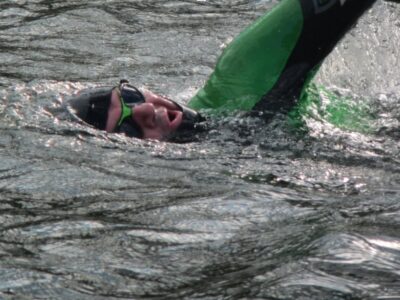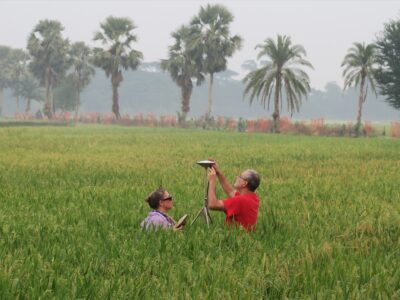Part 1 of a series on tracking landscape changes in Bangladesh.
I’ve returned to Bangladesh for maintenance and repairs on my GNSS (GPS) systems. I have two sets of stations, one in the northeast of the country to study the tectonics and earthquake hazard, and one in the south to look and land subsidence in the face of climate change and sea level rise. While the GNSS in your car or phone can tell you where you are to 10-15 feet, my more expensive systems can determine positions to about 2 mm (1/12”) horizontally and 6 mm (1/4”) vertically. I set them up in fixed locations, and then I can see the earth slowly move over years.

I’ve now been here two dozen times with many American colleagues, and have experienced working with many Bangladeshi students and scientists. On this trip, I spent the first week here in Dhaka, the capital, having meetings. One highlight has been that the first line of the new Metro system has opened. Austin Chadwick, my postdoc and I got to travel most of the length of the line. It is entirely elevated and much better than trying to travel across the city by car in its mind-numbing traffic. Sanju Singha, a Dhaka University graduate who has been working with my for the past 6 years, helped us get our Metro Card.

The other highlight has been being in Dhaka for Language Day. I remembers the effort to get Pakistan, when Bangladesh was East Pakistan, to recognize Bangla as an official language, instead of just Urdu, which is not spoken here. The protests culminated in the military firing into a crowd near Dhaka University and killing several people on February 21, 1952. It is now commemorated with a celebration of the language and recalling the memory of those who sacrificed for it. The UN has adopted it as International Mother Language Day and it is celebrated in a number of other countries.

On Language Day, I gave a virtual talk for a conference in Mizoram, India. Then Austin and I went out to the book fair. It is an enormous outdoor experience. At one end was the stage for Sesampur – the Bangladeshi Sesame Street – surrounded by booths with children’s book. The acres of book stalls were filled with people dressed for the occasion. Afterwards, we met Sanju and walked to the Shaheed Minar, the memorial set up on the site of the shooting. It was thronged with people. All the major dignitaries of Bangladesh, from the Prime Minister on down, had brought flower wreaths earlier in the day. Then we walked around the university and to one of my favorite restaurants for dinner.

With the end of the Sunday-Thursday work week, we headed to the field accompanied by a team of Dhaka University students. I am mainly working with Zohur Ahmed on the GNSS repairs. GPS is now used to refer to the U.S. Global Positioning System, while GNSS—Global Navigation Satellite System encompasses all of these satellite positioning arrays, including Russian, Chinese and European satellite as well. Austin is doing augering, hand drilling into the sediment to sample the soils with Masud Rana. This is my 7th trip with Masud, who has now gotten a position as a lecturer at Bangladesh Open University. The other members of the team are Sazzad (Sheak Sazzad Mahmud) and Tanvir (Ashraful Alam Tanvir) who will do the twice yearly measurement of elevation change and sedimentation at the RSET-MH (Rod Surface Elevation Table-Marker Horizon) that are installed near the GNSS. In fact, Austin and I are really tagging along on their regular spring service run. Our driver is Rafiq.

The three systems provide complementary data on the landscape changes in Bangladesh. The GNSS will measure the subsidence of the land below the buildings that they are mounted on. The RSET-MH will measure the subsidence caused by sediment compaction above the base of the rod at 80’ below the ground. It does this by carefully measuring elevation with the RSET and the sediment accumulation with the MH. The difference is the shallow subsidence. Finally, for the first time we are adding augering. The auger will be driven into the ground to take sediment samples. These will be analyzed back at Dhaka University to help us understand how the different sediment types, such as sand vs mud, contribute to our subsidence results. Over the next few years Austin will be developing a model to quantitatively understand the values across Bangladesh. These results will be important for the sustainability of the Ganges-Brahmaputra Delta and Bangladesh. Sea level rise is augmented by land subsidence, but countered by sedimentation building up the land. Understanding how these three factor balance is critical to this low-lying land.

Although we started early on Friday, we still hit a lot of traffic getting out of Dhaka as one of the bridges was closed for repairs. It had cleared up by the time we crossed the Padma River, the combined Ganges and Brahmaputra, on the almost 4 mile long Padma Bridge. It was the first chance for Austin, a fluvial geomorphologist, to see this tremendous river. We continued south past Patuakhali, where we have equipment, to Khepupara to service a GPS that I installed back in 2012, while the rest of the teams continued to the RSET site a little farther south near Kuakata. We have not had any remote connection to this site, at a weather radar station, since mid-2022. Surprisingly, we found the instrument still running. After struggling to remember how to connect and download the data, Zohur and I recovered over 500 day files of data. It turned out that the SIM card was shot and not functioning, not that the instrument had failed. We changed the batteries to the fresh ones we brought and left the station to continue recording until I can return with a new SIM card on another trip.

We picked up the others and drove to our hotel at the beach town of Kuakata. After a dinner of Bangladeshi barbeque, we walked to the beach to see the waves. This beach has been eroding, but it was still packed with people in the pleasant February evening.

The next morning, we started early, stopping for breakfast along the way. We went back to Patuakhali, specifically the Patuakhali Science and Technology University (PSTU) where we have the misnamed PUST station. This GNSS station is still running, so no need to down load data, but the batteries are wearing out, so we installed two new 45 Ah lead-acid batteries. A call back to the EarthScope Consortium (formerly UNAVCO) engineer who will join me later confirmed that it was working well.

Our work done, we joined the others. Zohur helped with the RSET team, and I joined Austin and Masud sampling using an auger (when not taking photos). The ground in the field we very hard, but got softer when we reached the water table. Austin and Masud resorted to standing in the auger to get it in. With several rounds of driving it in and removing the core, we got down to 1.6 m (5.3 ft) and took samples every 10 cm. We didn’t finish until around 3 pm, so lunch consisted of snacks in the car for the 4 hour drive to Khulna. Austin and I are getting to know the other members of our team during the long hours in the van.

The next day we drove 3 hours to Sonatola. Here I have two GNSS systems. One is on a building, like most of them, the other is mounted on an RSET rod very close to the RSET. This will allow us to measure the subsidence components above and below the rod at this site, in addition to the RSET – building GNSS comparison. All of the instruments here were installed in July 2019, so they are just approaching the 5 years needed for reliable estimates of the rates. Still we can see that the building sites, with a shallower foundation is subsiding faster than the sites on the deep RSET rod. At the site on the building, we downloaded the stored data, but could not get the modem to connect to its phone service. Later, the team at the EarthScope Consortium (formerly UNAVCO) that provides geodetic support services for NSF told me that it connected. Meanwhile, the RSET and auger teams did their work. We will repeat the split into 3 teams, with GNSS, Auger and RSET-MH teams, for all the sites over the next 10 days.





